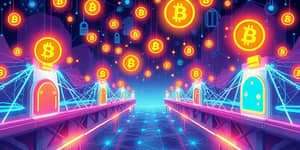
Real-world asset (RWA) tokenization is reshaping finance by converting tangible and intangible assets into digital tokens on a blockchain. This emerging paradigm empowers investors with new levels of accessibility, security, and liquidity. From high-value real estate to rare art, tokenization unlocks opportunities for fractional ownership and seamless global trading.
In this comprehensive exploration, we delve into the mechanics, market dynamics, benefits, risks, and future trends of tokenizing real-world assets. Whether you are a seasoned professional or a curious newcomer, you will gain actionable insights on how digital tokens are transforming asset ownership and financial markets.
Asset tokenization is the process of creating digital representations of ownership rights to physical or digital assets on a blockchain. These tokens can be fungible units or unique digital collectibles, granting investors either uniform shares or distinct, non-fungible ownership. By embedding asset rights into smart contracts, tokenization provides an immutable and transparent record of ownership and transactions.
This process enables fractional ownership and global market access by lowering barriers to entry and allowing investors to purchase portions of high-value assets. The result is a democratized investment landscape where liquidity and transparency are significantly enhanced.
The global asset tokenization market is on an unprecedented growth trajectory. Projected to reach $2.08 trillion by 2025 with a compound annual growth rate (CAGR) of 45.46%, analysts expect the market to surge to $13.55 trillion by 2030. In the RWA segment alone, on-chain assets surpassed $50 billion in 2025 and are forecast to reach $500 billion by year-end.
In the first half of 2025, the RWA market experienced a staggering 260% increase, jumping from $8.6 billion to over $23 billion. This explosive growth underscores investor appetite for tokenized assets and highlights the transformative impact of blockchain technology on traditional finance.
At the core of RWA tokenization lies a robust technology infrastructure. Most solutions leverage established blockchain platforms like Ethereum (ERC-20, ERC-721), Binance Smart Chain, Tezos, and enterprise frameworks such as Hyperledger Fabric. Key components include:
Decentralization and security: Peer-to-peer networks with cryptographic safeguards ensure tamper-resistant ledgers. Smart contracts automate issuance, compliance, and income distribution. Interoperability protocols and layer-two scaling solutions address performance and cost challenges, paving the way for seamless global integration.
Transforming a property into digital tokens involves several steps:
Despite its promise, asset tokenization faces hurdles. Regulatory uncertainty remains a major barrier, as jurisdictions grapple with classifying digital tokens. In the United States, many RWAs fall under securities laws enforced by the SEC, requiring issuers to navigate complex compliance landscapes.
Valuation and custody concerns arise when transferring off-chain asset values on-chain. Ensuring accurate appraisals, reliable custodianship, and legal recourse demands robust frameworks. Technical issues such as scalability, interoperability, and user experience also present significant challenges, while counterparty risks underscore the need for trusted issuers.
Recent regulatory milestones in 2025 signal incremental progress. The SEC’s guidance on crypto staking and pending stablecoin collateralization bills like the GENIUS Act demonstrate a shifting policy landscape. However, a dedicated RWA framework is yet to emerge, leaving issuers awaiting clearer rules.
Institutional involvement continues to rise, with major banks, asset managers, and fintech innovators piloting tokenization projects. Integration with AI, decentralized physical infrastructure networks (DePIN), and emerging asset classes such as carbon credits and subscription rights will drive the next wave of growth. Experts predict a $3.5 trillion DePIN market by 2028, catalyzed by tokenization.
Real-world asset tokenization stands at the intersection of finance and technology, offering unprecedented opportunities for investors and issuers alike. By unlocking liquidity and democratizing access, tokenization is redefining asset ownership and market dynamics.
As regulatory frameworks mature and technology scales, tokenized assets will become an integral component of diversified portfolios. Embracing this innovation requires careful consideration of legal, operational, and technical factors, but the potential rewards—a more inclusive, efficient, and transparent financial ecosystem—are immense.
Whether you are an institutional investor, asset owner, or developer, now is the time to explore real-world asset tokenization and position yourself at the forefront of this financial revolution.
References













